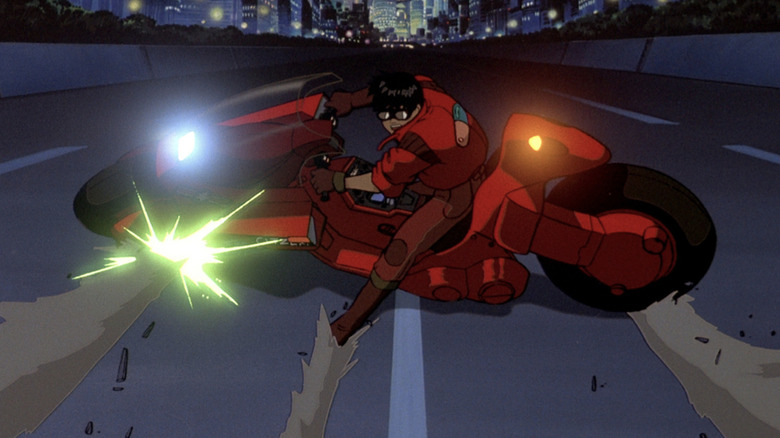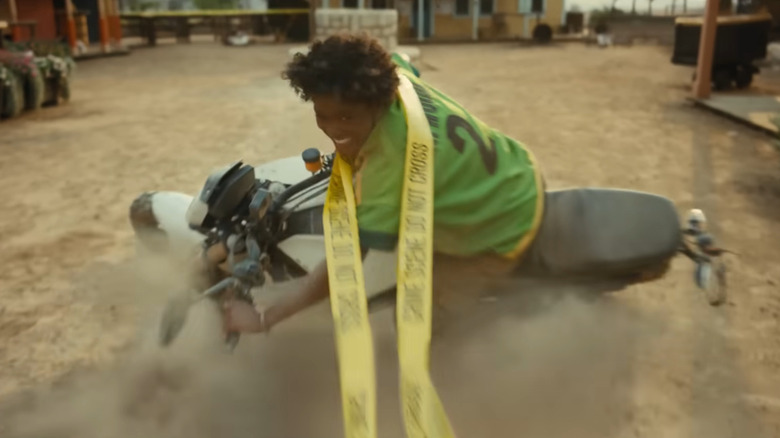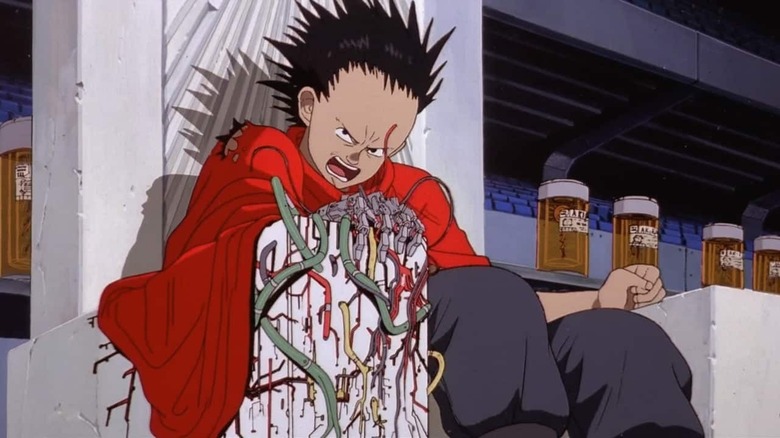The Anime That Inspired That Cool Motorcycle Move In Nope
There are few anime films out there that have inspired as many tributes to its animation and iconography as Katsuhiro Otomo's "Akira." Released in theaters in 1988, "Akira" became the gold standard for Japanese animation and was a milestone for the medium that would become so popular today. The cyberpunk action film told its story with striking imagery, and delved into themes of post-war trauma and disaffected youth that are still resonant to this day. The film has inspired new generations of fans and filmmakers, with the "Akira" bike slide becoming a staple of the film and thus spawning a myriad of homages and recreations in film and television.
One such film is one of the most anticipated movies this summer, Jordan Peele's "Nope." The film, set for a North American release this coming weekend, features a particular shot that will undoubtedly become an excellent addition to "Akira" bike slide homages. "Nope" centers around caretakers at a California ranch, OJ (Daniel Kaluuya) and Emerald (Keke Palmer) Haywood, siblings who come into contact with something that's seemingly otherworldly. Peele looks to combine his usual approach to horror with spectacle in "Nope" while throwing in a meaningful homage or two along the way.
The Akira bike slide
Featured in a TV spot for "Nope," viewers can see a brief shot of Keke Palmer's character Emerald on a motorcycle, recreating the bike slide that the character Kaneda does at the beginning of "Akira." While there have been plenty of animated tributes in shows such as "Batman the Animated Series" and "Adventure Time," a live-action "Akira" bike slide homage is few and far between.
Jordan Peele is clearly a fan of the film and was even in the running at one point to direct the live-action adaptation of the film. However, in an interview with IndieWire, Peele revealed he preferred to work on original content instead:
"'Akira' is one of my favorite movies, and I think obviously the story justifies as big a budget as you can possibly dream of. But the real question for me is: Do I want to do pre-existing material, or do I want to do original content? At the end of the day, I want to do original stuff."
"Nope" looks to be another hit for Jordan Peele, solidifying himself as one of the leading creatives in original horror. However, Jordan Peele's hesitancy to adapt pre-existing material and creative urge to tell his own original stories give this specific homage in "Nope" a deeper context, specifically regarding "Akira" and its relationship to Hollywood and its attempts to adapt it.
Originality over iconography
"Akira" has always been a cautionary tale that parallels real-world history. The dystopian vision of "Akira" presented a bold and original new form of storytelling. The stunning animation of the film, paired with its cyberpunk world design and surprising violence that was unexpected in the medium of animation at the time, all helped to give "Akira" a long-lasting impact. Tetsuo and Kaneda's story was something never seen before at the time of its release in 1988.
While it appears that Peele appears to respect this, unfortunately, Hollywood doesn't see the themes, story, or originality of "Akira" as its selling point, but rather its iconography. "Akira's" aesthetic has been at the center of Hollywood's desperate need to create a live-action remake, with several prominent directors involved at one point or another.
In a way, Peele's placement of this homage in "Nope" sends a message about his relationship with "Akira." Long rumored to be a part of the project but ultimately striving to tell his own original stories, Peele's homage becomes double-sided, in one way acknowledging the impact of "Akira" and, on the other, a meta-reference to Hollywood's shallow efforts to cash in on the legacy of a genre-defining film.
At the end of the day, Jordan Peele got the best of both worlds, telling his original story all while sliding (pun intended) in a reference to one of the best animated films ever made.


